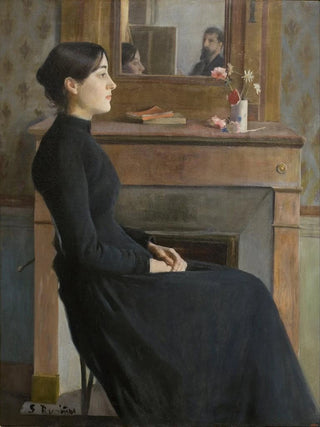Art print | Female figure - Santiago Rusiñol Source: Reproduction | Figure féminine - Santiago Rusiñol


View from behind

Frame (optional)
Santiago Rusiñol's artwork "Figure féminine" is a true invitation to immerse oneself in the fascinating world of Spanish modernist painting. This painting, imbued with delicacy and poetry, immediately captures attention through its subtle and evocative depiction of femininity. Rusiñol, a master of symbolism, succeeds in translating complex emotions through forms and colors that seem to dance across the canvas. The artist's vision unfolds here as a tribute to beauty and sensuality, while also evoking a certain melancholy. Contemplating this piece transports the viewer to a world where time appears suspended, where each brushstroke tells a story and every shade of color evokes emotion.
Style and uniqueness of the work
Rusiñol's style is distinguished by a bold use of color and an expressive approach that transcends mere realism. In "Figure féminine," the chromatic palette chosen by the artist is both rich and nuanced, oscillating between soft tones and vibrant flashes that create a harmonious balance. The forms, although stylized, retain a certain fluidity, evoking the natural grace of the female body. Rusiñol skillfully plays with light, creating delicate shadows that add depth to the composition. This piece is not limited to a simple representation; it is an exploration of the human soul, a quest for identity and inner beauty. Every detail, every gesture, seems charged with meaning, inviting the viewer to linger and discover the multiple layers of significance hidden behind the surface.
The artist and his influence
Santiago Rusiñol, an emblematic figure of Catalan modernism, established himself as a pioneer in the art world at the end of the 19th century and the beginning of the 20th century. His work reflects not only his exceptional talent but also his commitment to profound social and cultural themes. Rusiñol always sought to express the nuances of human experience, drawing inspiration from the literary and artistic movements of his time. Influenced by artists such as Vincent van Gogh and Paul Gau

Matte finish

View from behind

Frame (optional)
Santiago Rusiñol's artwork "Figure féminine" is a true invitation to immerse oneself in the fascinating world of Spanish modernist painting. This painting, imbued with delicacy and poetry, immediately captures attention through its subtle and evocative depiction of femininity. Rusiñol, a master of symbolism, succeeds in translating complex emotions through forms and colors that seem to dance across the canvas. The artist's vision unfolds here as a tribute to beauty and sensuality, while also evoking a certain melancholy. Contemplating this piece transports the viewer to a world where time appears suspended, where each brushstroke tells a story and every shade of color evokes emotion.
Style and uniqueness of the work
Rusiñol's style is distinguished by a bold use of color and an expressive approach that transcends mere realism. In "Figure féminine," the chromatic palette chosen by the artist is both rich and nuanced, oscillating between soft tones and vibrant flashes that create a harmonious balance. The forms, although stylized, retain a certain fluidity, evoking the natural grace of the female body. Rusiñol skillfully plays with light, creating delicate shadows that add depth to the composition. This piece is not limited to a simple representation; it is an exploration of the human soul, a quest for identity and inner beauty. Every detail, every gesture, seems charged with meaning, inviting the viewer to linger and discover the multiple layers of significance hidden behind the surface.
The artist and his influence
Santiago Rusiñol, an emblematic figure of Catalan modernism, established himself as a pioneer in the art world at the end of the 19th century and the beginning of the 20th century. His work reflects not only his exceptional talent but also his commitment to profound social and cultural themes. Rusiñol always sought to express the nuances of human experience, drawing inspiration from the literary and artistic movements of his time. Influenced by artists such as Vincent van Gogh and Paul Gau






